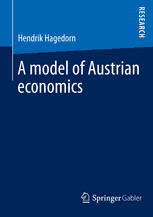
A model of Austrian economics PDF
Preview A model of Austrian economics
A model of Austrian economics Hendrik Hagedorn A model of Austrian economics Hendrik Hagedorn Münster, Germany Dissertation, Universität Münster, 2013 D6 ISBN 978-3-658-07076-2 ISBN 978-3-658-07077-9 (eBook) DOI 10.1007/978-3-658-07077-9 Th e Deutsche Nationalbibliothek lists this publication in the Deutsche Nationalbibliografi e; detailed bibliographic data are available in the Internet at http://dnb.d-nb.de. Library of Congress Control Number: 2014947964 Springer Gabler © Springer Fachmedien Wiesbaden 2015 Th is work is subject to copyright. All rights are reserved by the Publisher, whether the whole or part of the material is concerned, specifi cally the rights of translation, reprinting, reuse of illustrations, recitation, broadcasting, reproduction on microfi lms or in any other physical way, and transmission or information storage and retrieval, electronic adaptation, compu- ter soft ware, or by similar or dissimilar methodology now known or hereaft er developed. Exempted from this legal reservation are brief excerpts in connection with reviews or schol- arly analysis or material supplied specifi cally for the purpose of being entered and executed on a computer system, for exclusive use by the purchaser of the work. Duplication of this publication or parts thereof is permitted only under the provisions of the Copyright Law of the Publisher’s location, in its current version, and permission for use must always be obtained from Springer. Permissions for use may be obtained through RightsLink at the Copyright Clearance Center. Violations are liable to prosecution under the respective Copyright Law. Th e use of general descriptive names, registered names, trademarks, service marks, etc. in this publication does not imply, even in the absence of a specifi c statement, that such names are exempt from the relevant protective laws and regulations and therefore free for general use. While the advice and information in this book are believed to be true and accurate at the date of publication, neither the authors nor the editors nor the publisher can accept any legal re- sponsibility for any errors or omissions that may be made. Th e publisher makes no warranty, express or implied, with respect to the material contained herein. Printed on acid-free paper Springer Gabler is a brand of Springer DE. Springer DE is part of Springer Science+Business Media. www.springer-gabler.de IwouldliketothankProf.HansHermannLechner,Prof.UlrichvanSuntum,Dr.StefanKooths, Dr.PascalSeppecher, theLudwig-von-Mises Institute,andmyentirefamily.Thisworkwould nothavebeenpossiblewithouttheirguidanceandsupport.Moreover,IthankAdamLedererand AlexanderMaltforproofreadingthemanuscriptandHellaSteinkeforimprovingitslayout. Berlin,April9,2014 HendrikHagedorn Contents 1 Introduction.................................................. 1 2 Thesetupofthemodel......................................... 5 2.1 Amonetarymarketeconomy................................ 5 2.2 Physicalcapital ........................................... 9 2.3 Thefinancialsystem ....................................... 12 2.3.1 Accounting ........................................ 12 2.3.2 Firmcreation,equityrequirements,bankruptcy .......... 15 2.4 Timeperiods ............................................. 18 2.5 Nationalaccounting ....................................... 20 3 Householdbehavior ........................................... 23 3.1 Purchasesandmoneydemand ............................... 23 3.2 Pre-incomepreferencesandappraisement ..................... 27 4 Firmbehavior ................................................ 31 4.1 Schedulesforproductionandoffers .......................... 32 4.2 Thesalesstrategy ......................................... 33 4.3 Liquiditymanagement ..................................... 36 4.4 Productionmanagement .................................... 39 4.5 Theinvestmentrationale.................................... 40 4.5.1 Operations......................................... 40 4.5.2 Fixedcapital ....................................... 42 5 Bankbehavior ................................................ 43 5.1 Liquiditymanagement ..................................... 43 VIII Contents 5.2 Commercialbanking....................................... 44 6 Thefunctioningofthemodel ................................... 49 6.1 Competitionandsteadystates ............................... 49 6.2 Thesystemicview......................................... 52 6.3 Preferencechanges ........................................ 56 7 Results....................................................... 61 7.1 Generalresults............................................ 63 7.2 Achangeinrelativepreferences ............................. 63 7.3 Changesintimepreferences ................................ 72 8 Considerationsaboutinterestrates.............................. 81 9 Furtheraspects ............................................... 87 9.1 Thecharacterofthismodel ................................. 87 9.2 Uncertaintyandspontaneousorder ........................... 91 9.3 Onpreferences............................................ 93 A ListofSymbols ............................................... 97 References........................................................101 Chapter 1 Introduction AlthoughAustrianeconomicshasmanyferventfollowers,its relativepopularity withinthescienceofeconomicsislimited.Neoclassicaleconomics,withitsDSGE modeling,1isfarmorevisibletonotjustthegeneralpublicbutalsoamongstthose educatingfutureeconomists.Thissinglefocushasnotgonewithoutdebateandthe discussionwasrenewedafterthemostrecentfinancialcrisis(Hicks,1981;Solow, 2008; Caballero, 2010). Without doubt, limiting economic research to only one methodologicalstandardpreventsthescientificcommunityfromincorporatingthe insightsofthosefieldsofeconomicsthathavedevelopedindependentofthisstan- dard(Caballero,2010).Therefore,someofthemainthemesthatwereelaborated byAustrianscholars,suchasthetheoryofcapital,thetheoryofentrepreneurship, and the theory of the money-drivenbusiness cycle, have not or only to a small extentbeaccommodatedbyneoclassicaleconomics. What inhibits mainstream economists from adopting these theories is, on the one hand, the absence of a general modeling approach for Austrian economics and,ontheotherhand,thattheneoclassicalapproachisfundamentallyunsuitedto capturetheseinsights.Asdemonstratedby Mirowski(1989),theconceptofgen- eral equilibriumis not at all a natural approachto economic thinking. Rather is the equilibriumapproachan attempt to transcribe the metaphorsof 19th century physicstoeconomicphenomena.However,inordertoobtainsuchatranscription it is necessaryto makecompromisesbetweenmathematicaltractabilityandeco- nomic realism. And hence the equilibriumperspectiveeasily becomes distorted. The “law of one price” is a case in point: it provides equilibrium models with thesymmetrythatisnecessarytoemulateaconservationprincipleofthephysical 1 DSGEisanabbreviationfordynamicstochasticgeneralequilibrium.DSGEmodelsarealso used innew-Keynesian economics, butthe termneoclassical ishere used as tocomprise both strandsofliterature. H. Hagedorn, A model of Austrian economics, DOI 10.1007/978-3-658-07077-9_1, © Springer Fachmedien Wiesbaden 2015 2 1 Introduction sciences,butitisforeigntoalleconomicprocesses.Infact,itispricedispersion and not price unity which allows markets to developtheir coordinatingfunction (Gintis,2007). Onasimilarnote,thecompliancewiththegeneralequilibriumframeworkled economiststomakewidespreaduseoftherationalexpectationsframework,whose flawshavelongbeenexposed(e.g.Davidson,1983).Again,thesymmetrybetween futurestatesoftheworldandtheexpectationthereofdoesnotrepresenteconomic insight,butisonlypostulatedoutofmathematicalnecessity.Thedilemmaofmod- ernmacroeconomicscanthusbeframedasfollows:Theneedformathematically tractablemodelshasledtoageneralacceptanceofpremisesthatarehighlyunre- alisticatbestandhaveoftenprovokedaseriousdealofconfusion. Thisworkprovidesapossiblesolutiontothisdilemma.Itdoessobydeveloping a model that synthesizes elements of post-Keynesianeconomicsand complexity economicswiththecentraltenetsofAustrianeconomicstherebyportrayingAus- trianeconomicsinaformalandcoherentway.Themodelthatisthusestablished is just as general as a DSGE model, but it is by all means more realistic and it treats macroeconomicsfrom an entirely differentperspective. At the same time, theproposedmodelprovidesa mathematicallyrigidframeworkunderwhichthe propositionsoftheAustrianschoolcanbescrutinized. ThecenterpieceoftheAustrianschoolisthestudyoftheformalimplications ofhumanaction,adisciplinethatAustrianscallpraxeology(Mises,[1949]2008, pp.1). Economics, according to this research paradigm, is only a subdiscipline ofpraxeology.Thismethodologicalperspectivehasmanyconsequences.First,in Austrianeconomics,valuationnotonlyoriginatesfromthehumanmindaloneand isthereforesubjective,butalsoarevaluationsonlyexpressedthroughaction.On theotherhand,thethingsthathumanbeingsvalueareinherentlyheterogeneous. Thus, in essence, Austrian economics describes the world on the basis of a dy- namictheoryofsubjectivevalueandatheoryofheterogeneouscapital.Second,in Austrianeconomicsall economicagentsare treated as true economicactors and notasmerereactorstotheirenvironment,asischaracteristicfortheneoclassical school.TheAustrianperspectivethusimpliesthatalleconomicanalysisisbased ontheprincipleofcauseandeffect,which,asacorollary,impliesthepassageof time.Austrianeconomicsthereforedepictstheeconomyasaprocess,asopposed tothestaticinterdependencyofneoclassicaleconomics. Furthermore, what distinguishes Austrian economics from other schools of thoughtisitspurelytheoreticandessentialistcharacter.Sinceonlytheformalim- plicationsofthefactthathumanbeingsactaredescribed,Austrianeconomicsis notconcernedwith thespecific choicesmadebyindividualsorwith thecircum- stancesunderwhichsuchchoicesarise.AccordingtotheAustrianunderstanding suchinquirybelongstodifferentfieldsofscience,namelypsychologyandhistory. 1 Introduction 3 Austrianeconomicsconfinesitselftostatementsthataretrueforallactionsmade byhumanbeings.Thesestatementsaretrueapriorilikethestatementsofmath- ematics and logic and they are not subject to verification or falsification on the groundofexperienceandfacts(Mises,[1949]2008,pp.32).Forinstance,thelaw ofdiminishingmarginalutilityislogicallyimpliedintheconceptofaction(Mises, [1949]2008,pp.119).AlmostnothinginAustrianeconomicsisassumed.Onlyba- sicpremiseslike,e.g.,capitalbeingheterogeneousaretakenasself-evidentlytrue andarethustakenforgranted(Rothbard,1957).Hence,thisapproachassumesal- mostuniversalvalidity.Themechanismsunderlyingtheproposedmodelarefirmly rooted in this causal-realist and non-positivistic world view. This serves as the model’sepistemologicalfoundation.Also,Austrianeconomicsishereunderstood inthisnarrowsense.MuchofwhatrunsundertheheadingofAustrianeconomics todayisnotdirectlyimpliedbythelogicofaction,butratherbyalogicofchoice and equilibrium-likeconcepts (Gloria-Palermo, 1999). However,the idea of this model is to emphasize the essentialist character of the Austrian approachand to describe economic insights based on processes that are driven by human action alone. The concrete modeling approach taken in the following is agent-based and accounting-based.Thatis,alleconomicactivityinthemodelresultsfromthede- centralizedactions of agents. These agents exchangegoodsand services against money on virtual markets and each of them has a balance sheet that reflects his financial and economic situation. Implicitly, the agents serve as an interface be- tween two economicdomains.On the one hand,they pursue certainpre-defined goalsandthusrepresentbehavioralaspectsofthemodelwhile,ontheotherhand, theyapplystandardaccountingrulesinordertokeeptrackoftheireconomicsitua- tionandthusembodyacalculativeelementwithinthemodel.Onthebasisofthese calculationsanyresultthatthemodelproducescanbeexaminedviaitseffecton the system of national accounts. Moreover,the application of an economy-wide accountingscheme means that all markets in which the agents interact are fully interdependent.Yet,thisinterdependencyisnotachievedbyimposingsynchronic- ity,as theequationsofmotionthatgovernDSGEmodelsdo,butratheremerges fromwithin. The agent-based character of this model thus makes it possible to conduct macroeconomic research while only specifying microeconomic behavior and, moreover,to reconcile the modeling of complex systems with the praxeological researchprogram.Thisalsomeansthatthemodeldoesexhibitgenuinemicrofoun- dations,butthesemustnotbeconfoundedwiththemicrofoundationsofneoclassi- caleconomics.Sinceallagentsinthismodeloperateunderknowledgeconstraints and uncertainty and since all their actions are bound in historic time the notion ofthehomooeconomicus,whichisgermanetoneoclassicaleconomics,cannotbe
